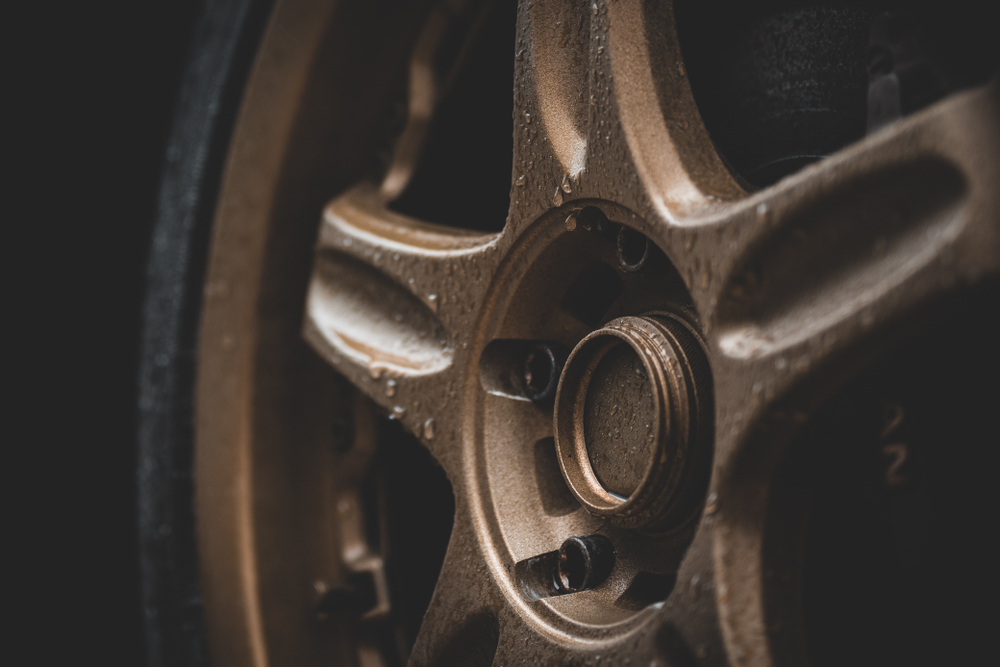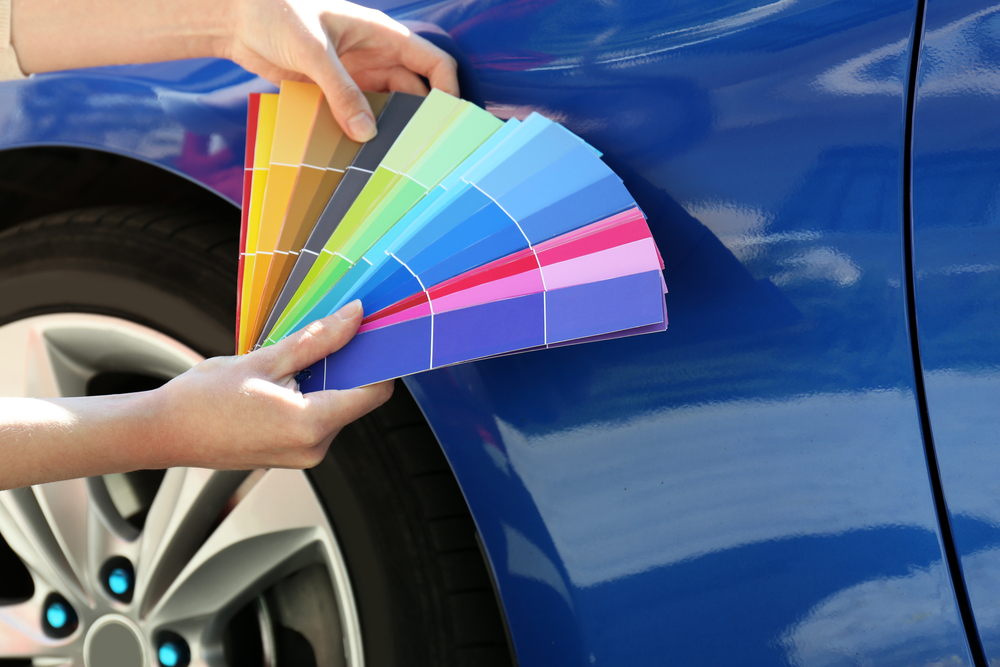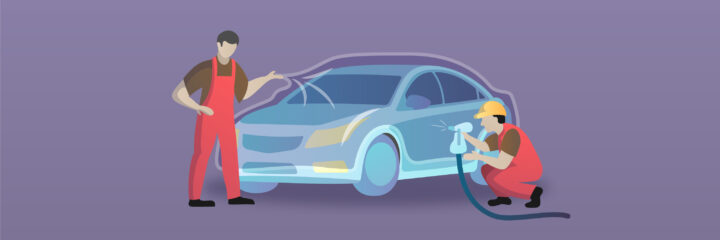Since the late 2000s, “dipping” your car has been a great alternative to a traditional paint job if you want to change the color of your ride. The price and DIY accessibility make it perfect for people who customize cars on a budget, and the unique looks you can get are sure to turn heads wherever you drive.
Is it worth it, though? What is plasti dip anyway? In this article, we are going to give you an overview. We’ll explain what it is, layout the advantages, and quickly describe the application process. We’ll finish with some alternatives, that way you can make the best decision about the future of your project car.
What Is Plasti Dip
“Plasti Dip” is actually a brand, but just like Kleenex or Crescent Wrench, it now refers to any PVC-based paint or “rubberized coating.” Flexi-Dip, AutoFlex, and others are other brands that offer a similar product. Still, the term plasti dip has become universal, although many times it’s simply shortened to “dip” or called “liquid wrap.”
No matter what you call it, it is a product that gets applied to your car like paint. It is most often sprayed on using a special sprayer or an aerosol can. People will often dip their wheels or a few trim pieces to add an accent to their car, but it’s not uncommon to see entire cars coated in the product. It has a handful of advantages and disadvantages compared to a traditional paint job.
Advantages of Plasti Dipping Your Car
The following items are the biggest advantages to dipping your car.
It’s Less Expensive
Cost is one of the biggest advantages of dipping your car. A good paint job from a reputable shop will cost over $2,000. The entire plasti dip kit, including the sprayer needed, can be as low as $500 from DYC. DYC, or www.dipyourcar.com, is one of the biggest car dipping websites out there and has one of the largest selections of products that you can get.
It’s Easy to Apply
To paint a car correctly, you need to remove the old paint first. Then you have to disassemble your car, fill, sand, tape, primer, sand, primer, sand, paint, sand, paint, clearcoat, and polish. It takes a long time and requires a ton of work.
Dipping your car just requires a quick clean, mask, and spray. The more coats, the better the finish, and it’s easy to simply cut away overspray.
It’s Easy to Remove
People love wraps and plasti dip because they are easy to remove. If you dip your car but decide you don’t really like the color, you just peel the dip off. It won’t hurt your original paint, and it’s easy to apply a new color over the top.
It’s Easy to Maintain
Plasti dip is very durable, but it can scratch just like paint. It’s incredibly easy to fix the scratch, though, since the entire finish is one component. You just spray some more product on the damaged area, and you’re done. Vinyl is good for many things, but you can’t fix it nearly as easily as you can fix dip; plasti dip is unrivaled in that regard.
The Community Is Massive
If you ever want to dip your car, there is a gigantic online and offline community waiting to answer any question you might have or inspire you with pictures. We mentioned DYC above, but there are also robust sections of Reddit and YouTube dedicated to dipping your car.
Disadvantages of Plasti Dipping Your Car
There are some downsides to dipping your car. Beware of myths that spread easily online. We’ll cover some in a moment, but first, we’ll talk about the cons of plasti dip.
It Doesn’t Last as Long
A good paint job or vinyl wrap should have no issue lasting more than 5 years. A great paint job will last 20; there are even cars that came from the factory with such good paint that they still look acceptable even 30 years later. By comparison, plasti dip will last about three years.
More advanced liquid wrap products might look good for five, but those cost a bit more. The price and ease of reapplication are supposed to offset the longevity issues.
The Color and Finish Selection Is Limited
When plasti dip first came out, it was very limited in colors and finishes. In fact, there was no gloss option. Nowadays there are a lot more colors to choose from, and there are some gloss options.
It still pales in scope compared to paint, though, which can have additives like metal flake or ultra-high gloss finishes and can be mixed for literally any color on the visible spectrum.
It’s Not Very Strong
The downside to the dip being easily removable is that debris and contact can remove it fairly easily. Scraping against flora will damage the finish, and spilling gas on your car can dissolve the product entirely.
It is easy to fix; as we mentioned above, all you have to do is apply more of the same color, and the problems disappear. Compared to paint and vinyl, though, it’s also much easier to damage.
Common Plasti Dip Myths

There are a lot of opinions about dipping your car floating around. It’s impossible to go to any car forum or website and not at least see it mentioned, and any car meet will include at least one dipped car. Unfortunately, this means that there is a lot of misinformation about it as well.
You Can’t Clean Your Plasti Dipped Car
False
You can clean your dipped car the same way you’d clean any car. Just be aware that some solvents and cleaners shouldn’t be used. Specifically, petroleum products and dissolvents like acetone should be avoided. You shouldn’t be using those products on a traditional paint job anyway, but plasti dip is especially prone to damage by those products.
Plasti Dip Only Lasts for Less Than a Year
False
With a proper coating, plasti dip is very resilient and can easily last 3+ years with minimal maintenance. There are plasti dip like products on the market that last much longer, however. The Auto Flex line can easily last 5+ years, which is as long as any inexpensive paint job can be expected to last.
Plasti Dip Damages Paint
False
Dipping cars have been popular for over 10 years, and there is very little evidence that it can cause damage to your paint. Issues can arise, though, if your paint is in poor condition. Paint that is already flaking or damaged can be ripped apart when removing the plastic.
Plasti Dip Can’t Be Shiny
Mostly False
This used to be true, but modern plasti dip products can have the same gloss and extra gloss finish that you would expect from paint and vinyl. However, these products tend to be more expensive and more difficult to work with. That limits their advantages over a traditional paint job, so most dipped cars have a matte or flat finish.
Plasti Dip Is Actually More Expensive Than Vinyl Wrap
It Depends
One of the big arguments against plasti dip is that a good vinyl wrap will actually be cheaper and be much better for your car. This can be true; a professional vinyl wrap shop can sometimes apply the wrap cheaper than a paint shop can apply plasti dip. If you are doing it yourself, though, plasti dipping is much less expensive.
How to Dip Your Car

If you are thinking about dipping your car (or the wheels, or the badge, etc.), you should familiarize yourself with the basic application process. Most people who dip their cars do it themselves since all the cost-saving is in labor and the ease of application is a major selling point.
Some shops will dip your car, which can be a good option for people who don’t have the time to DIY it but still want the unique properties of plasti dip. That can have a very similar cost to an inexpensive paint job or good vinyl wrap, though, so it’s somewhat rare.
Before You Start
One of the most helpful things you can do before you think about dipping your ride is to watch someone fail. Donut Media had a great little series called High-Low where someone with no experience tried to dip their Nissan. It didn’t go well at all, and it’s a very real representation of what you might be getting yourself into.
The good news is that they tried again and succeeded in a big way by working with DYC, so it is doable. It’s just good to know what’s what before diving in.
The Basic Process
There are 5 main steps to dipping your car. Each step has a few details that we are only going to gloss over, but there are thousands of videos and an entire online academy from DYC that you can use if you really want to dive into it.
Wash and Dry the Car
The car needs to be completely clean of grease and debris before you apply the dip. It also needs to be completely dry. For best results, you’ll want to do a really deep clean a few days before, a quick clean the day before, and all night to dry completely.
Mask Areas You Don’t Want Painted
You’ll use tape and plastic to block off anything you don’t want to be sprayed. This is a step that is required for all painting. It doesn’t matter if you are painting your house or pinstriping a truck; the better you mask, the better the result.
This step may require a bit of pre-planning. You may want to color sections differently, and you’ll have to decide ahead of time whether you want to dip things like mirrors and grills. Make sure to use fresh tape. Old painter’s tape can leave a residue, or worse, fail to seal and let overspray in.
Spray the Material
To start, mix the material, thin it if necessary, and load the sprayer. When spraying, remember that consistent, even passes are the secret. It’s always a good idea to practice on something like a cardboard box.
One of the biggest things to keep in mind when using any sprayer is to mind the arc. When you spray across an area, there is a tendency to swing your arm from left to right or right to left. When you do that, the spray will be further away when you start, get closer, then move further away as you finish. You don’t want that. The best results will come from being able to keep the sprayer the same distance away from the car at all times.
You’ll be spraying the entire car 5+ times, so don’t worry if your first few coats are only ok.
Peel the Tape Off
There are two different stages of tape removal.
The first stage is the wet peel. Basically, anywhere there isn’t a grooved transition or gap will need the tape peeled off immediately after spraying. If you wait too long, the tape will rip the product as you remove it, and you’ll need to use a razor blade to cut the transition line, which is both tedious and carries the risk of scratching the finish.
The second stage is the dry stage, which is simply the process of removing all the masking you didn’t remove when it was wet. Big areas like windshields and body components like the roof are usually safe to leave until the dip is dry.
Apply the Finishing Products
When the car is completely dry, spray and apply your finishing product. There are a few different products on the market, and some people don’t do this step, but it can really help protect the car in the long run. Treat the finishing product as if it was any detailing spray: use clean cloths, work in small areas, and stop if you notice streaks.
Plasti Dip Alternatives
Dipping has two major competitors in the auto world: traditional paint jobs and vinyl wrapping.
Paint
Paint is the traditional way to change a car’s color, and it’s what most cars have from the factory. A good paint job is a lot more expensive than both dipping and wrapping, but it’s a lot more durable as well. Done correctly, a paint job will last 10+ years.
The biggest advantage, though, is the level of customizability that paint gives. Paint can give you any color or finish, and the only limit to the design and pattern is the painter’s skill.
Vinyl Wrap
Vinyl is the most common color customization that is compared to dip. It is also removable, can be similarly DIYed, and is considerably cheaper than paint. It’s slightly more durable than dip, and it can come in more colors and finishes, but it’s also less customizable.
The biggest difference is in the application process, though. Vinyl comes in rolls and must be “shrunk” onto your car. It can be a very difficult process and usually requires help. That difficulty is why people will outsource vinyl wrapping to shops dedicated to the process.
Color the World
Dipping your car is a really rewarding thing to do. It can feel amazing when you step back and see your car in the sunlight after you put the work into a great finish. The accessibility and price make it a perfect beginner project, and it can really complete any build.
Most of all, have fun with it. Cars are about expression, and part of the expression is the process.


